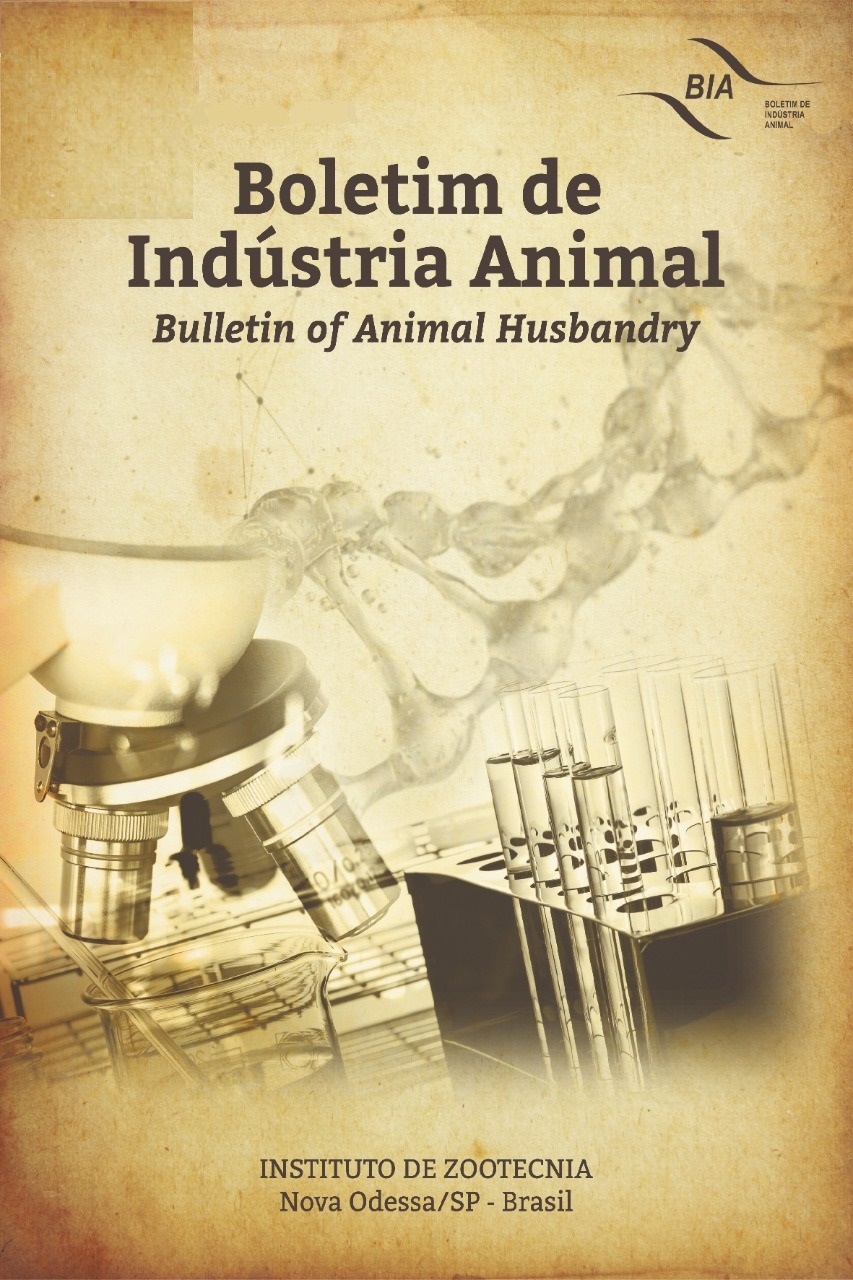Evaluation bruises incidence in cattle slaughtered in a slaughterhouse located in São Paulo, Brazil
DOI:
https://doi.org/10.17523/bia.2025.v82.e1943Keywords:
animal welfare, bovine transport, bruisesAbstract
Pre-slaughter handling of cattle can increase animal stress, making them more susceptible to carcass bruising. Such bruising negatively impacts the beef production chain, affecting both producers and slaughterhouses. In this context, the present study aimed to evaluate the incidence of bruises in cattle carcasses at a slaughterhouse located in the northwest region of São Paulo State, Brazil, under the supervision of the State Inspection Service (SISP). A total of 1,068 carcasses were assessed between September and December 2021. Data were collected on breed type, sex, age, travel distance, and truck model, along with the extent, severity, and location of the bruises. Among the evaluated carcasses, 64.7% were crossbred (zebu and taurine). The findings indicated that older females, with slaughter age of 25 to 36 months, were more susceptible to bruises compared to males. The hindquarter cuts were the most affected areas, with a predominance of bruises in animals transported by truck over distances of 101 to 150 km. Furthermore, the most frequent bruises were classified as grade II (51.4%) and measured between 6 and 10 cm in size (36.8%). Various factors contribute to the occurrence of bruises in beef cattle such as racial pattern, gender, age and distance travel, however, most of these factors could be prevented or mitigated through proper management practices during the pre-slaughter period.
Downloads
References
ABIEC, Associação Brasileira das Indústrias Exportadoras de Carne. Available in: https://www.abiec.com.br/wp-content/uploads/Final-Beef-Report-2023-Completo-Versao-web.pdf Accessed on: 11/11/2024.
ANEZI-JUNIOR, P.A.; CARVALHO, P.A. Ocorrência, classificação e quantificação de contusões em carcaças de bovinos abatidos em Frigorífico no RS. PUBVET, v. 15, p. 1-8, 2021. https://doi.org/10.31533/pubvet.v15n01a724.1-8
AMERICAN VETERINARY MEDICAL ASSOCIATION. AVMA guidelines for the humane slaughter of animals: 2024 edition. American Veterinary Medical Association, 2024.
BARINGTON, K.; SKOVGAARD, K.; HENRIKSEN, N.L.; JENSEN, H.E. Optimising the sampling procedure for forensic investigation of brises on pigs. Veterinary Recordin, v. 187, 2020. https://doi.org/10.1136/vr.105625
BARINGTON, K.; AGGER, J.F.C.; NIELSEN, S.S.; SICH-JORGENSEN, K.; JENSEN, H.E. Gross and histopathological evaluation of human inflicted bruises in Danish slaugther pigs. BMC Veterinary Research, v. 12, p. 1-6, 2016. https://doi.org/2010.1186/s12917-016-0869-3Co
BETHANCOURT-GARCIA, J.A.; VAZ, R.Z.; VAZ, F.N.; SILVA, W.B.; PASCOAL, L.L.; MENDONÇA, F.S.; VARA, C.C.; NUÑEZ, A.J.C.; RESTLE, J. Pre-slaughter factors affecting the incidence of severe bruising in cattle carcasses. Livestock Science, v. 222, p. 41–48, 2019. https://doi.org/10.1016/j.livsci.2019.02.009
BOTÍA, M.; ESCRIBANO, D.; ORTÍN-BUSTILLO, A.; LÓPEZ-MARTINEZ, M.J.; FUENTES, P.; JIMÉNEZ-CAPARRÓS, F.J.; HERNÁNDEZ-GÓMEZ, J.L.; AVELLANEDA, A.; CERÓN, J.J.; RUBIO, C.P.; TVARIJONAVICIUTE, A.; MARTINEZ-SUBIELA, S.; LÓPEZ-ARJONA, M.; TECLES, F. Comparison of the effect of two diferente handling conditions at slaughter in saliva analytes in pigs. Metabolites, v. 14, 2024. https://doi.org/10.3390/metabo14040234
BRAZIL, Ministério da Agricultura, Pecuária e Abastecimento Secretaria de Inspeção de Produto Animal. PORTARIA Nº 5, de 8 de novembro de 1988. Brasília, 1988.
CLARIGET, J.; BANCHERO, G.; LUZARDO, S.; FERNÁNDEZ, E.; PÉREZ, E.; LA MANNA, A.; SARAVIA, A.; DEL CAMPO, M.; FERRÉS, A.; CANOZZI, M.E.A. Effect of pre-slaughter fasting duration on physiology, carcass and meat quality in beef cattle finished on pastures or feedlot. Research in Veterinary Science, v. 136, p. 158-165, 2021. https://doi.org/10.1016/j.rvsc.2021.02.018
DEL CAMPO, M.; MANTECA. X.; DE LIMA, J.M.S.; BRITO, G.; HERNÁNDEZ, P.; SAÑUDO, C.; MONTOSSI, F. Effect of different finishing strategies and steer temperament on animal welfare and instrumental meat tenderness. Animals, v. 11, p. 1–21, 2021. https://doi.org/10.3390/ani11030859
D’OCCHIO, M.J.; BARUSELLI, P.S.; CAMPANILE, G. Influence of nutrition, body condition, and metabolic status on reproduction in female beef cattle: a review. Theriogenology, v.125, 2019. https://doi.org/10.1016/j.theriogenology.2018.11.010
EUROPEAN COMMISSION. EU meat market observatory - beef and veal. EU remainder for calves and young cattle, 2022.
GENARO, C.M.L. Electro-thermal injuries in ruminants caused by electrical equipment during pre-slaughter operations: foresis case reports from and animal welfares Science perspective. Forensic Science International, v. 356, p. 1-8, 2024. https://doi.org/10.1016/j.forsciint.2024.111936
GENARO, C.M.L.; GONZÁLEZ-CASTRO, C.A.; GUTIÉRREZ-PIÑA, F.J.; VILLARROEL, M.; MARIA, G.A.; ESTÉVEZ-MORENO, L.X. Horse welfare at slaughter: a novel approach to Analyse brised carcasses based on severity, damage patterns and their association with pre-slaughter risk factors. Meat Science, v.172, p. 1-10, 2021. https://doi.org/10.1016/j.meatsci.2020.108341
IBGE - Brazilian Institute of Geography and Statistics. Available in: https://www.ibge.gov.br/explica/producao-agropecuaria/bovinos/br Accessed on: 10/11/2024
LEE, T.J.; REINHARDT, C.D.; BARTLE, S.J.; VAHL. C.I.; SIEMENS, M.; THOMSON, D.U. Assessment of risk factors contributing to carcass brising in fed cattle ar commercial slaughter facilities. Translational Animal Science, v.1, p. 489-487. https://doi.org/10.2527/tas2017.0055
LOSADA-ESPINOSA, N.; ESTÉVEZ-MORENO, L.X.; BAUTISTA-FERNÁNDEZ, M.; GALINDO, F.; SALEM, A.Z.M.; MIRANDA-DE-LAMA, G.C. Cattle welfare assessment at the slaughterhouse level: Integrated risk profiles based on the animal’s origin, pre-slaughter logistics, and iceberg indicators. Preventive Veterinary Medicine, v. 197, p. 1-9, 2021. https://doi.org/10.1016/j.prevetmed.2021.105513
McWHORTER, T.M.; HUTCHISON, J.L.; NORMAN, H.D.; COLE, J.B.; FOK, G.C.; LOURENCO, D.A.L.; VANRADEN, P.M. Investigating conception rate for beef service sires bred to dairy cows and heifers. Journal of Dairy Science, v. 103, p. 1-9, 2020. https://doi.org/10.3168/jds.2020-18399
MOREIRA, L.C.; ROSA, G.J.M.; SCHAEFER, D.M. Beef production from cull Dairy cows: A review from culling to consumption. Journal of Animal Science, v. 99, p. 1–18, 2021. https://doi.org/10.1093/jas/skab192
MOTA-ROJAS, D.; WHITTAKER, A.L.; ORIHUELA, A.; DOMÍNGUEZ-OLIVA, A.; MORA-MEDINA, P.; ÁLVAREZ-MACÍAS, A.; HERNÁNDEZ-AVALOS, I.; OLMOS-HERNÁNDEZ, A.; REYES-SOTELO, B.; GRANDIN, T. Human animal relationships in Bos indicus cattle breeds addressed from a Five Domanins welfare framework. Frontiers in Veterinary Science, v. 3. https://doi.org/10.3389/fvets.2024.1456120
NESPOLO, J.C.; MANINI, D.L.; GOMES, J.E.G.; SALOTTI-SOUZA, B.M. Ocurrence of injuries related to handling in carcasses of beef cattle slaughtered in a slaughterhouse located in the Northwest region of the state of São Paulo. Boletim de Indústria Animal, 79, 2022. https://doi.org/10.17523/bia.2022.v79.e1514
NJISANE, Y.Z.; MUCHENJE, V. Farm to abattoir conditions, animal factors and their subsequent effects on cattle behavioural responses and beef quality — A review. Asian-Australasian Journal of Animal Sciences, v. 30, p. 755-765, 2017. https://doi.org/10.5713/ajas.16.0037
ÖZDEMIR, S.; EKIZ, B. Effects of certain risk factors on presence and severity of carcass bruising in cattle: A stury in Turkey. Meat Science, v. 202, p. 1-8, 2023. https://doi.org/10.1016/j.meatsci.2023.109199
PELAYO, J.S.; ELIAS-JÚNIOR, A.R.; LIMA, N.R.; NAVARRO, A.; ROCHA, S.P.D. Detection of diarrheagenic Escherichia coli in bovine meat in the Northern region of Paraná state, Brazil. Brazilian Archives of Biology and Technology, v. 62, p. 1-11, 2019. https://doi.org/10.1590/1678-4324-2019180012
ROADKNIGHT, N.; MANSELL, P.; JONGMAN, E.; COURTMAN, N.; FISHER, A. Invited review: The welfare of young calves transported by road. Journal of Dairy Science, v. 104, p. 6343-6357, 2020. https//doi.org/10.3168/jds.2020-19346
SARAIVA, S.; ESTEVES, A.; OLIVEIRA, I.; MITCHELL, M.; STILWELL, G. Impacto f pre-slaughter factors on welfare of broilers. Veterinary and Animal Science, v. 10, p.1-7. https://doi.org/10.1016/j.vas.2020.100146
VAZ, R.Z.; DUTRA, M.M.M.; BETHANCOURT-GARCIA, J.A.; PASCOAL, L.L.; VAZ, F.N.; SARTORI, D.B.S.; REIS, N.P.; RESTLE, J. Intrinsic and environmental factors in the pre-slaughter behavior of beef cattle. Journal of Veterinary Behavior, v. 63, 2023. https://doi.org/10.1016/j.jveb.2023.05.003
VICIC, I.; PETROVIC, M.Z.; DIMITRIJEVIC, M.; GRKOVIC, N.; SINDIC, M.; KARABASIL, N. Maind pre-slaughter factors affecting carcass bruising and meat quality in beef cattle. Veterinary Research Communications, p. 49-56. https://doi.org/10.1007/s11259-024-10625-4
YOUNGERS, M.E.; THOMSON, D.U.; SCHWANDT, E.F.; SIMROTH J.C.; BARTLE, S.J.; SIEMENS, M.G.; REINHARDT, C.D. Prevalence of horns and bruising in feedlot cattle at slaughter. The Professional Animal Scientist, v. 33, p. 135-139, 2017. https//doi.org/10.15232/pas.2016-01551
Downloads
Published
Issue
Section
License
Copyright (c) 2025 Bulletin of Animal Husbandry

This work is licensed under a Creative Commons Attribution-NonCommercial-NoDerivatives 4.0 International License.
Os autores não serão remunerados pela publicação de trabalhos, pois devem abrir mão de seus direitos autorais em favor deste periódico. Por outro lado, os autores ficam autorizados a publicar seus artigos, simultaneamente, em repositórios da instituição de sua origem, desde que citada a fonte da publicação original seja Boletim de Indústria Animal. A revista se reserva o direito de efetuar, nos originais, alterações de ordem normativa, ortográfica e gramatical, com vistas a manter o padrão culto da língua e a credibilidade do veículo. Respeitará, no entanto, o estilo de escrever dos autores. Alterações, correções ou sugestões de ordem conceitual serão encaminhadas aos autores, quando necessário. Nesses casos, os artigos, depois de adequados, deverão ser submetidos a nova apreciação. As opiniões emitidas pelos autores dos artigos são de sua exclusiva responsabilidade. Todo o conteúdo deste periódico, exceto onde está identificado, está licenciado sob a Licença Creative Commons Attribution (CC-BY-NC). A condição BY implica que os licenciados podem copiar, distribuir, exibir e executar a obra e fazer trabalhos derivados com base em que só se dão o autor ou licenciante os créditos na forma especificada por estes. A cláusula NC significa que os licenciados podem copiar, distribuir, exibir e executar a obra e fazer trabalhos derivados com base apenas para fins não comerciais.













